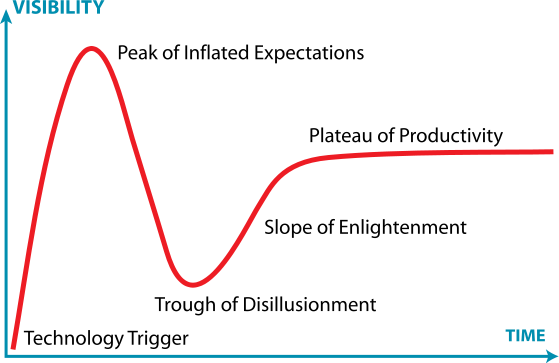
In the past few years I have been part of many technology implementations revolving around ShipConstructor as well as enterprise solutions such as PLM, PDM, ERP and MRP. For some of these projects I am involved right from the start of the project but some I am requested to join in the middle of the implementation. In a recent implementation project I joined the team roughly in the middle of the integration project. When I joined the project it was not going very well and it did not look like it would have a bright future. There was a disconnect between the stakeholders’ expectations of what the solution should do and what was understood and designed by the implementation team. This is a common scenario and while I was getting familiar with the project I had a realization that many implementation projects followed very closely the Hype Cycle for Emerging Technologies. This project was in the Trough of Disillusionment phase.
Hype Cycle

For those who are not familiar with the Hype Cycle, the image above explains it pretty well.
There are 5 main phases of the Hype Cycle
- Technology Trigger
- Peak of Inflated Expectations
- Trough of Disillusionment
- Slope of Enlightenment
- Plateau of Productivity
I will relate my experience with most implementation projects to this Hype Cycle.
Technology Trigger
There are many triggers that initiate an implementation project but the three that I have seen the most are:
- The need to support a more complex project that has not been attempted by the organization.
- The need to support a project with multi-vessel deliverables.
- The need to enhance processes, tools and people communication to improve investment and throughput across the organization.
These are just some examples but no matter what the reason for starting the implementation project the start to the Peak of Inflated Expectations always starts from here.
Peak of Inflated Expectations
Even before the official start of the implementation project there has been a build-up of buzz within the company about what this project will be capable of doing and how it will be the best thing the company has ever done. To be honest this is a necessary evil since without this buzz it would be likely the project would not get approved by the executive team.
At the official start of the project (“The Kick-Off”) a number of things happen. All the stakeholders provide their needs (more accurately “wants”). Vaguely defined goals of the project are set (never seem vague at the time). Scope is also loosely defined. Imagination, creativity and “what if” scenarios are what really drives these initial discussions. It is quite fun to be involved at this stage because everyone seems to have the energy and motivation to make this project work.
This is where the project increases very rapidly up to the Peak of Inflated Expectations. The challenge at this early stage is not that the technology and systems cannot provide what is dreamt of but rather the true goals of the project start to include goals which are simply out of scope within the time frame and budget allotted for the project. The thirst for doing everything that is technically possible infects everyone and really blinds us from what is actually needed and doable.
Trough of Disillusionment
The Trough of Disillusionment is where reality starts to set in and when the rubber hits the road. The team tries to start architecting and implementing to solve the unrealistic goals set out at the initial phases.
At this stage the non-understood assumptions starts to peak through and cause several severe roadblocks. For instance, custom databases which were supposedly to be replaced are no longer going to be because they are in the tight ownership of a group of people who refuse to let go of a system that they have grown and nurtured like their own child. This now requires another system or multiple systems to be included in the architecture. This incubates discussions arguments of where information is going to live, who is going to “own” the data as well as disjointed workflows required to support systems which need to be customized to work in the big picture.
This slide down to the Trough of Disillusionment has multiple vendors competing with each other to continually increase their dominance and footprint on the final solution.
The list goes on and on…trust me. All of this leads us down to the Trough of Disillusionment very quickly. At the bottom of this phase there is no longer a single team but rather multiple mini teams trying to impose what they think the solution should be. The degree of this varies depending on the team members but it is safe to say that it no longer feels like an united team.
I have to admit when/if you reach this point you wonder if it is still worth proceeding. You wonder to yourself “could my time be spent somewhere else where I could see a positive outcome.” I personally have never given up at this stage but it is common that you lose a few of the original team members.
Slope of Enlightenment
After you hit rock bottom and the project is on the verge of getting canceled or considered an Epic Fail, some important things start to happen.
First some very difficult questions get asked such as “what is the purpose and the goal of this project.” This simple question or a variation of it, is the first sign of getting back on track. This question is usually asked at the beginning of the project but as mentioned above, the path to the Peak of Inflated Expectations has us blinded and we absorbed much more into the requirements than is needed.
Answering this simple question is anything but simple. There is usually a lot of disagreements and fortunately only a small amount of conflict. After the goals are re-evaluated and clearly defined the team can re-focus on what is actually needed. The scope of the project is also now reasonable for the duration and investment left for the project.
Another main milestone which is on the Slope of Enlightenment is the first release of the implementation project. Most people call it a “Go Live Launch” but I really try to get the lexicon of Birth instead. What we mean by Going Live is better expressed by using the word Birth because after the project gives birth 🙂 (Goes live) there should be the expectation that not everything will magically work from the start. There are still going to be some tender love and care that is required to get the kinks worked out and some unanticipated bumps and bruises that need a quick Band-Aid fix. There will also be features that the user and implementation team want to leverage in future phases.
The lexicon of Birth instead of “Go Live” communicates to everyone that there may be some challenges ahead but it will be worth the pain because the system will grow and adapt into want is actually needed.
Plateau of Productivity
At this state, the implementation is becoming mature with minimal issues and changes to the system are not very active. There is always going to be maintenance but during the Plateau of Productivity there is no to very little active development or significant improvements planned.
Most of the team has been disbanded and working on another project (which will also follow the Hype Cycle).
For the more complex projects such as PLM implementations I have not reached this plateau very often or to be honest ever. The projects that I am still involved in are still in the Slope of Enlightenment. I do wonder if this is a common trend in more complex implementation project because the sheer amount of available features and new products makes the Slope of Enlightenment very long.
Closing remarks
The majority of the projects I have been involved in over the years follow the Hype Cycle very closely. Some have higher peaks and lower troughs as well as have different and nonlinear time scales but in essence all follow this.
In the last few projects I have strived for more of an agile method with short and measurable deliverables. With this strategy I think we still go through the same Hype Cycle. However, the peaks and troughs are not as pronounced. In essence the Hype Cycle becomes more flattened and cyclic which I do think is a positive.
I would like to hear if you have had the same experiences that I have as well as if you have not. Also, any guidance you can share on how we can use our understanding that projects will follow this Hype Cycle to our advantage would be greatly appreciated.
